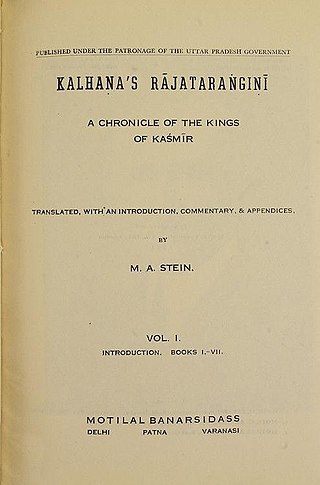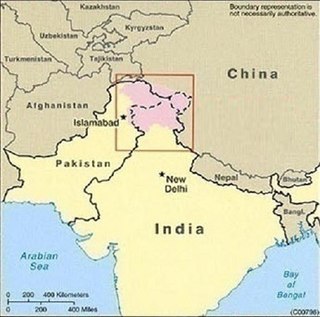Related Research Articles

The history of Kashmir is intertwined with the history of the broader Indian subcontinent in South Asia with influences from the surrounding regions of Central and East Asia. Historically, Kashmir referred to only the Kashmir Valley of the western Himalayas. Today, it denotes a larger area that includes the Indian-administered union territories of Jammu and Kashmir and Ladakh, the Pakistan-administered territories of Azad Kashmir and Gilgit-Baltistan, and the Chinese-administered regions of Aksai Chin and the Trans-Karakoram Tract.
Kalhana was the author of Rajatarangini, an account of the history of Kashmir. He wrote the work in Sanskrit between 1148 and 1149. All information regarding his life has to be deduced from his own writing, a major scholar of which is Mark Aurel Stein. Robin Donkin has argued that with the exception of Kalhana, "there are no [native Indian] literary works with a developed sense of chronology, or indeed much sense of place, before the thirteenth century".

Lalitaditya alias Muktapida was a monarch belonging to the Karkota dynasty of Kashmir region in the Indian subcontinent.

Rajatarangini is a metrical legendary and historical chronicle of the north-western part of India, particularly the kings of Kashmir. It was written in Sanskrit by Kashmiri historian Kalhana in the 12th century CE. The work consists of 7826 verses, which are divided between eight books called tarangas ("waves").

Buddhism was an important part of the classical Kashmiri culture, as is reflected in the Nilamata Purana and Kalhana's Rajatarangini. Buddhism is generally believed to have become dominant in Kashmir in the time of Emperor Ashoka, although it was widespread there long before his time, enjoying the patronage not only of Buddhist rulers but of Hindu rulers too. From Kashmir, it spread to the neighbouring Ladakh, Tibet and China proper. Accounts of patronage of Buddhism by the rulers of Kashmir are found in the Rajatarangini and also in the accounts of three Chinese visitors to Kashmir during 630-760 AD.

Harsha, also Harshadeva, was a Hindu king of Kashmir. Harsha was also known as "Nero of Kashmir", this "because of his cruelty". Harsha belonged to the First Lohara dynasty, of which he was the last ruler. According to Kalhana, Harsha was built like a god and was extremely handsome. Harsha's conduct has recently been a subject of discussion. Harsha started out as a capable and noble king, then ran into financial trouble because of his spending habits. He was the son of king Kalasha of Kashmir. According to Pandit Prithvi Nath Kaul Bamzai, A History of Kashmir, pp. 143,’ Kalhana mentioned even night soil was taxed under his rule. Extravagant expenditure on his troops and senseless pleasure involved him in grave financial difficulties .His accidental discovery of hoarded treasures at the Bhimasahi, induces him to spoilage other temple and he started melting gold and silver images of god and goddess’’

Achabal, known as Achival in Kashmiri, is a town in Anantnag district, in the union territory of Jammu and Kashmir, India.

Didda, also known as The Catherine of Kashmir, was the ruler of Kashmir from 980 CE to 1003 CE. She first acted as regent for her son and various grandsons from 958 CE to 980 CE, and from 980 CE as sole ruler and monarch. Most knowledge relating to her is obtained from the Rajatarangini, a work written by Kalhana in the twelfth century.

Sharada Peeth is a ruined Hindu temple and ancient centre of learning located in the Neelum Valley of Azad Kashmir, Pakistan. Between the 6th and 12th centuries CE, it was among the most prominent temple universities in the Indian subcontinent. Known in particular for its library, stories recount scholars travelling long distances to access its texts. It played a key role in the development and popularisation of the Sharada script in North India, causing the script to be named after it, and Kashmir to acquire the moniker "Sharada Desh", meaning "country of Sharada".

Sugandha was the ruler of Kashmir in the northern Indian subcontinent during the 10th century.
The Lohara dynasty were Hindu rulers of Kashmir in the northern part of the Indian subcontinent, between 1003 and approximately 1320 CE. The early history of the dynasty was described in the Rajatarangini, a work written by Kalhana in the mid-12th century and upon which many and perhaps all studies of the first 150 years of the dynasty depend. Subsequent accounts, which provide information up to and beyond the end of the dynasty come from Jonarāja and Śrīvara. The later rulers of the dynasty were weak: internecine fighting and corruption was endemic during this period, with only brief years of respite, making the dynasty vulnerable to the growth of Islamic conquests in the region.

Yashovarman was a medieval Indian ruler of Kannauj who founded the Varman dynasty of Kannauj. There are few sources that provide information of his life, although he was indubitably a powerful man.
The Karkota Dynasty ruled over the Kashmir valley and some northern parts of the Indian subcontinent during 7th and 8th centuries. Their rule saw a period of political expansion, economic prosperity and emergence of Kashmir as a centre of culture and scholarship.

Utpala dynasty was a Kashmiri kingdom which ruled over the Kashmir region in the northern part of the Indian subcontinent from 9th to 10th century CE. The kingdom was established by Avanti Varman, ending the rule of Karkota dynasty in 855 CE. The cities of Avantipur and Suyapur were founded during the reign and many Hindu temples dedicated to both Vishnu and Shiva and Buddhist monasteries were built, notable of which is the Avantiswara and Avantiswami temples.
The Second Gonanda dynasty, was a Kashmiri Hindu dynasty. According to Kalhana, this dynasty ruled Kashmir just before the Karkotas.

Sri Pravarasena, also sometimes Pravarasena II based on the regnal lists of the Rajatarangini, was a 6th-century Huna king of the Alchon Huns in the area of Gandhara and Kashmir in northwestern India. His reign probably lasted about 60 years from about the year 530 CE.

King Ashoka, of the Gonandiya dynasty, was a king of the region of Kashmir according to Kalhana, the 12th century CE historian who wrote the Rajatarangini.
Yudhishthira has been proposed as the last Alchon Hun ruler of Kashmir, according to a reconstruction made by Atreyi Biswas. The tentative identification has been made from the lists of Huna kings given in the Puranas and the Rajatarangini.

Toramana of Kashmir, was a ruler of Kashmir in the 6-7th century CE. This ruler has often been called "Toramana II" in numismatic studies, but this name now tends to be used for an earlier Alchon Hun ruler of Kabulistan: Toramana II.
Battle of Jammu was a battle fought on 27 February 1399. Timur invasion India
References
- ↑ "Rajatarangini" Encyclopædia Britannica. Encyclopædia Britannica Online. Encyclopædia Britannica Inc., 2011. Web. 17 December 2011.
- ↑ Students & Britannica India. 1. A to C - Page 254 Dale Hoiberg, Indu Ramchandani - 2000 "Book II introduces a new line of kings not mentioned in any other authentic source, starting with Pratapaditya I and ending with Aryaraja. Book III starts with an account of the reign of Meghavahana of the restored line of Gonanda and refers to ..."
- ↑ India and Indology: Selected Articles - Page 150 William Norman Brown, Rosane Rocher, American Institute of Indian Studies - 1978 "King Jayendra had a trusted minister named Samdhimati, whom, however, jealous courtiers persuaded him to reduce to disgrace and ... At this time a mysterious report spread from house to house, "To Samdhimati will belong the kingdom."
- ↑ Kalhana's Rajatarangini Rājataraṅgiṇi: the chronicle of the kings of Kaśmīr - Volume 1 : 1961 Page 81 "Samdhimati- Aryaraja who seems to have figured in Kasmlr tradition as the bean ideal of a royal devotee ... Fanciful as the story of Samdhimati- Aryaraja is as related in the Chronicle, we should yet scarcely be justified in treating the existence ..."
- ↑ Culture And Political History Of Kashmir ( 3 Vols. Set) - Page 111 P. N. K Bamzai - 1994 "The saintly hero of the tale is then supposed to have ascended the Kashmir throne vacated by Jayendra's death under the title of Aryaraja. He seems to be considered in the Kashmir traditions as an ideal saintly king who built shrines and ..."
- ↑ Vivekananda Kendra - Christianity in India: a critical study 1979 - Page 9 "Then Samdhiman Aryaraja, resplendent in divine garments and celestial ornaments, fell at the feet of his guru. The Kingless Srinagar citizens, one and all, who had heard about the miracle, reached the place and persuaded Samdhiman to ..."
- ↑ The Calcutta review 1850 - Volume 14 - Page 211 "Aryaraja, who, like Charles V., abdicated the throne, and refused to become king again, "raised his eyes to heaven, and was content with the empire of his soul ; he never resumed the reins of power, as a snake does not take the slough, which .."